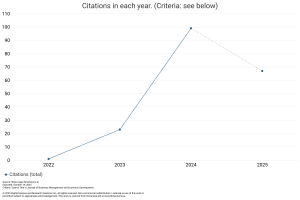Unveiling the Link between Customer Experience and Customer Loyalty on Blibli: The Mediating Role of Trust
DOI:
https://doi.org/10.59653/jbmed.v2i01.411Keywords:
Customer Experience, Trust, Customer Loyalty, E-commerceAbstract
The rapid growth of digital technology and the Internet has opened new avenues for business, particularly in the field of e-commerce. Online shopping has become the prevailing trend for purchasing goods and services, reshaping market dynamics. Blibli.com is a subsidiary of Djarum in the digital sector established in 2010 and is the original Indonesian e-commerce company that focuses on building the shopping ecosystem of choice for consumers and institutions through a secure omnichannel commerce platform. However, in a highly competitive environment, maintaining and increasing customer loyalty is a challenge. This study aims to explore the effect of customer experience on Blibli customer loyalty in Indonesia, with customer trust as an intermediary variable. This research uses a quantitative descriptive approach and path analysis, with a sample of 200 respondents who are Blibli application users. The results showed that customer experience and trust have a significant influence on customer loyalty. Data analysis shows that Blibli's app design, appearance, navigation, and payment process is highly rated by customers. Customers also had a positive emotional experience and high trust in Blibli's customer service and social media presence. This study also found that customer trust plays a role as a mediator in the relationship between customer experience and customer loyalty. Based on these findings, this study suggests Blibli to focus on increasing customer trust through improving customer experience to drive customer loyalty.
Downloads
References
Al-Msallam, S., & Alhaddad, A. (2016). The Effects of Social Media Marketing In the Hotel Industry: Conceptual Model for Development of an Effective Online Community. International Journal of Business and Management Invention, 5(7), 1-12.
Bei, L., and Chiao Y. (2001), “An Intergrated Model for The Effect of Percieved Product Quality, Percieved Service Quality, and Percieved Fairness on Consumer Satisfaction and Loyalty”, Journal of Consumer Satisfaction, dissatisfaction, and complaining behavior, Vol .14, pp. 125 – 140.
Blibli. (2023). About Blibli. Retrieved from https://about.blibli.com/id, accessed 12th November 2023.
De Keyser, A., Lemon, K. N., Klaus, P., & Keiningham, T. L. (2015). A framework for understanding and managing the customer experience. Marketing Science Institute Working Paper Series, 15(121), 1–48.
Ghozali, Imam, Hengky Latan. 2015. Konsep, Teknik, Aplikasi Menggunakan Smart PLS 3.0 Untuk Penelitian Empiris. BP Undip. SemarangHarnanto. 2017. Akuntansi Biaya: Sistem Biaya Historis. Yogyakarta: BPFE.
Hegner-Kakar, A. K., Richter, N. F., & Ringle, C. M. (2018). The customer loyalty cascade and its impact on profitability in financial services. Partial least squares structural equation modelling, 53-75.
Keiningham, T., Aksoy, L., Bruce, H. L., Cadet, F., Clennell, N., Hodgkinson, I. R., & Kearney, T. (2020). Customer experience-driven business model innovation. Journal of Business Research, 116, 431-440.
Klaus, P. P., & Maklan, S. (2012). EXQ: A multiple-item scale for assessing service experience. Journal of Service Management, 23(1), 5–33.
Klaus, P. P., & Maklan, S. (2013). Towards a better measure of customer experience. International Journal of Market Research, 55(2), 227–246.
Lemon, K. N., & Verhoef, P. C. (2016). Understanding customer experience throughout the customer journey. Journal of Marketing, 80(6), 69–96.
Leninkumar, V. (2017). The Relationship between Customer Satisfaction and Customer Trust on Customer Loyalty. International Journal of Academic Research in Business and Social Science, 7(4), 450-465.
Lerro, M., Raimondo, M., Stanco, M., Nazzaro, C., & Marotta, G. (2019). Cause Related Marketing among Millennial Consumers: The Role of Trust and Loyalty in the Food Industry. Sustainability, 11(2), 535.
Martin, D., Molina, A., Esteban A. 2007, “An integrated model of price, satisfaction and loyalty: an empirical analysis in the service sector” Journal of Product and Brand Management, Vol. 16 No.7, pp 459-468
Martinez, F. J., Calvo, A., & Salgado, L. M. (2021). Understanding Omnichannel Customer Experience Through Brand Trust and Its Impact on Shopping Intention. EasyChair.
McLean, G., Nabhani, K. A., & Wilson, A. (2018). Developing a Mobile Application Customer Experience Model (MACE) - Implications for Retailers. Journal of Business Research, 85, 325-336.
Ncube, J. (2020). The Impact of Mobile Banking Customer Experience on Loyalty Among Millennials In South Africa. Master's thesis, Faculty of Commerce.
Nurhayati, Hanadian. (2022). E-commerce in Indonesia – Statistic & Facts. Statista. Retrieved from www.statista.com.
Oliver, R.L. (1997), Satisfaction: A Behavioral Perspective on the Consumer. New York: Irwin/McGraw-Hill.
Oliver, R.L. 1999. “Whence Consumer Loyalty?”, Journal of Marketing, Vol. 63 No. 4, pp. 33- 44.
Rajaobelina, L., Brun, I., Tep, S. P., & Arcand, M. (2018). Towards a better understanding of mobile banking: the impact of customer experience on trust and commitment. Journal of financial services marketing, 23(3), 141- 152.
Sheth. Jagdish., & Mittal Banwari. (2004). Consumer Behaviour: A Managerial Perspective, second edition. Thompson Southwestern. The USA.
Sombut, N., & Sujchaphong, N. (2021). Effects of Customer Experience on Loyalty of 4-5 Star Hotel Business in Thailand. Doctoral dissertation, Mahasarakham University.
Sugiyono. (2018). Metode Penelitian Kuantitatif, Kualitatif, dan R&D. Bandung: Alfabeta.
Vallejo-Bojorque, M. A., Cavazos-Arroyo, J., Lagunez-Pérez, M. A., & Vásquez-Herrera, S. E. (2021). Customer experience, trust and loyalty of millennials in banking at Cuenca-Ecuador. Retos, 11(22).
Yoo, B., Donthu, N. and Lee, S. (2000), “An Examination of Selected Marketing Mix Element and Brand Equity”, Academy of Marketing Science, Vol.28 No.2, pp.195-211
Downloads
Published
How to Cite
Issue
Section
License
Copyright (c) 2023 Rennyta Yusiana, Ratih Hurriyati, Puspo Dewi Dirgantari

This work is licensed under a Creative Commons Attribution-ShareAlike 4.0 International License.
Authors who publish with this journal agree to the following terms:
- Authors retain copyright and grant the journal right of first publication with the work simultaneously licensed under a Creative Commons Attribution-ShareAlike that allows others to share the work with an acknowledgement of the work's authorship and initial publication in this journal.
- Authors are able to enter into separate, additional contractual arrangements for the non-exclusive distribution of the journal's published version of the work (e.g., post it to an institutional repository or publish it in a book), with an acknowledgement of its initial publication in this journal.
- Authors are permitted and encouraged to post their work online (e.g., in institutional repositories or on their website) prior to and during the submission process, as it can lead to productive exchanges, as well as earlier and greater citation of published work (See The Effect of Open Access).





























